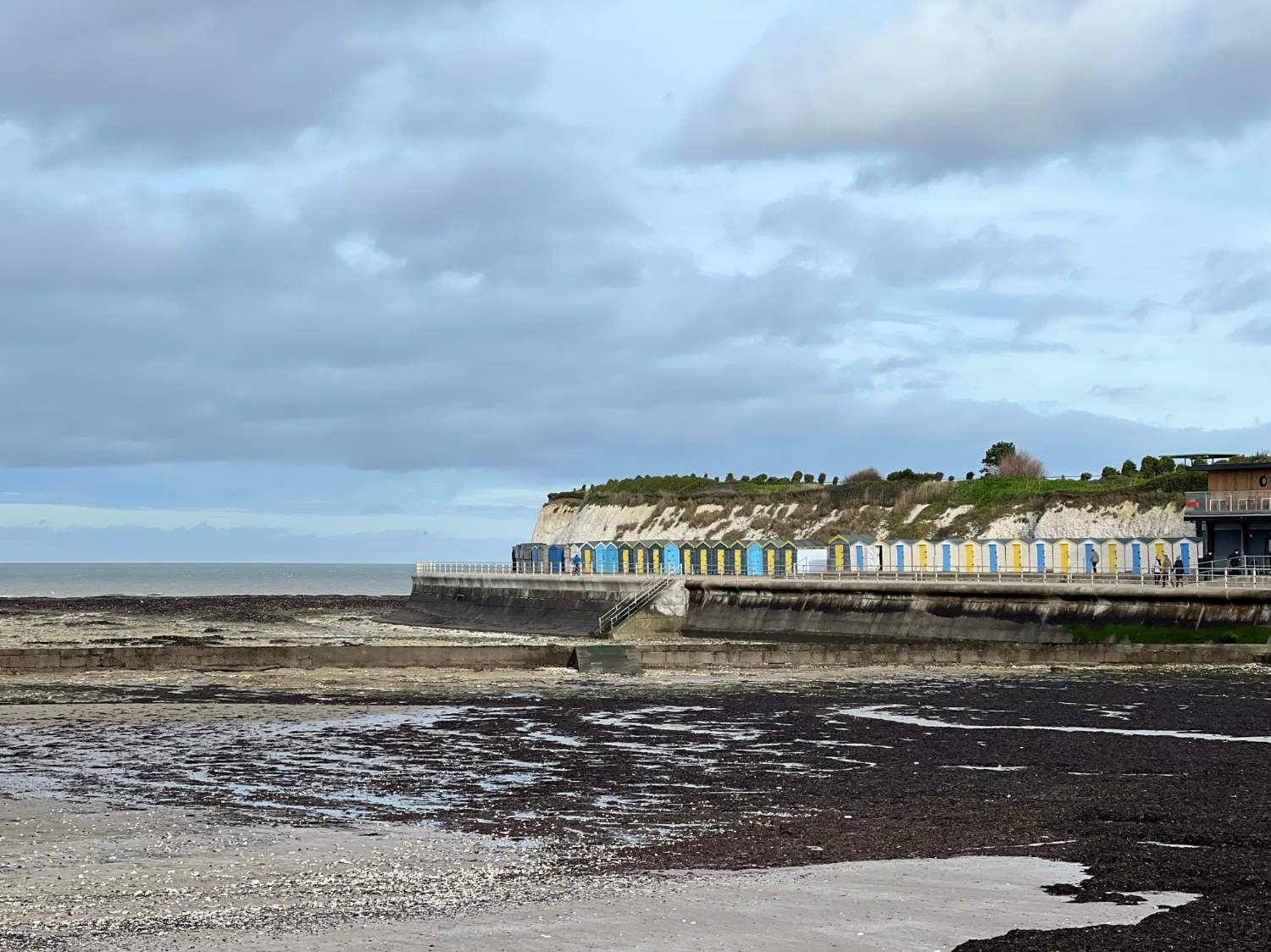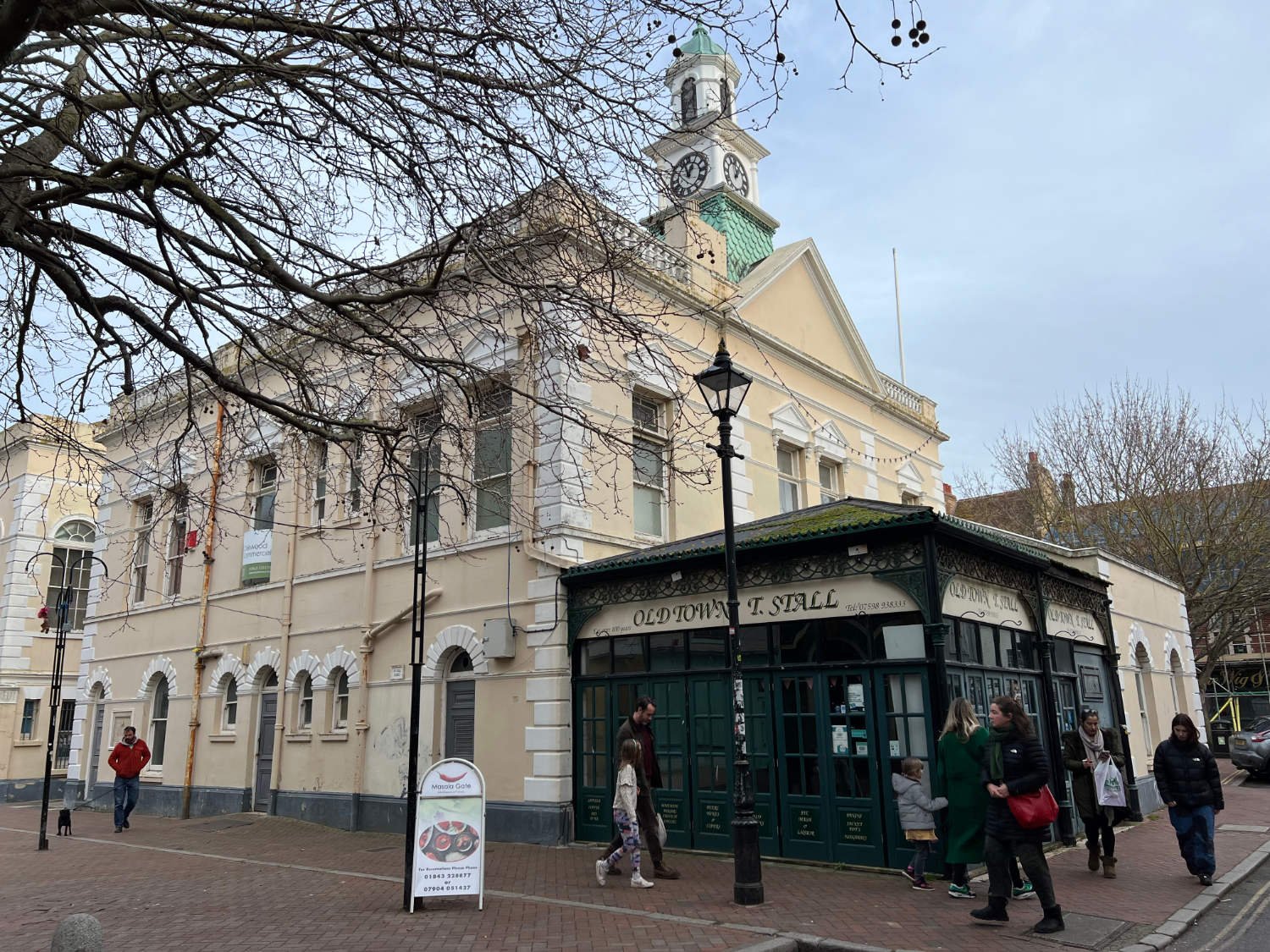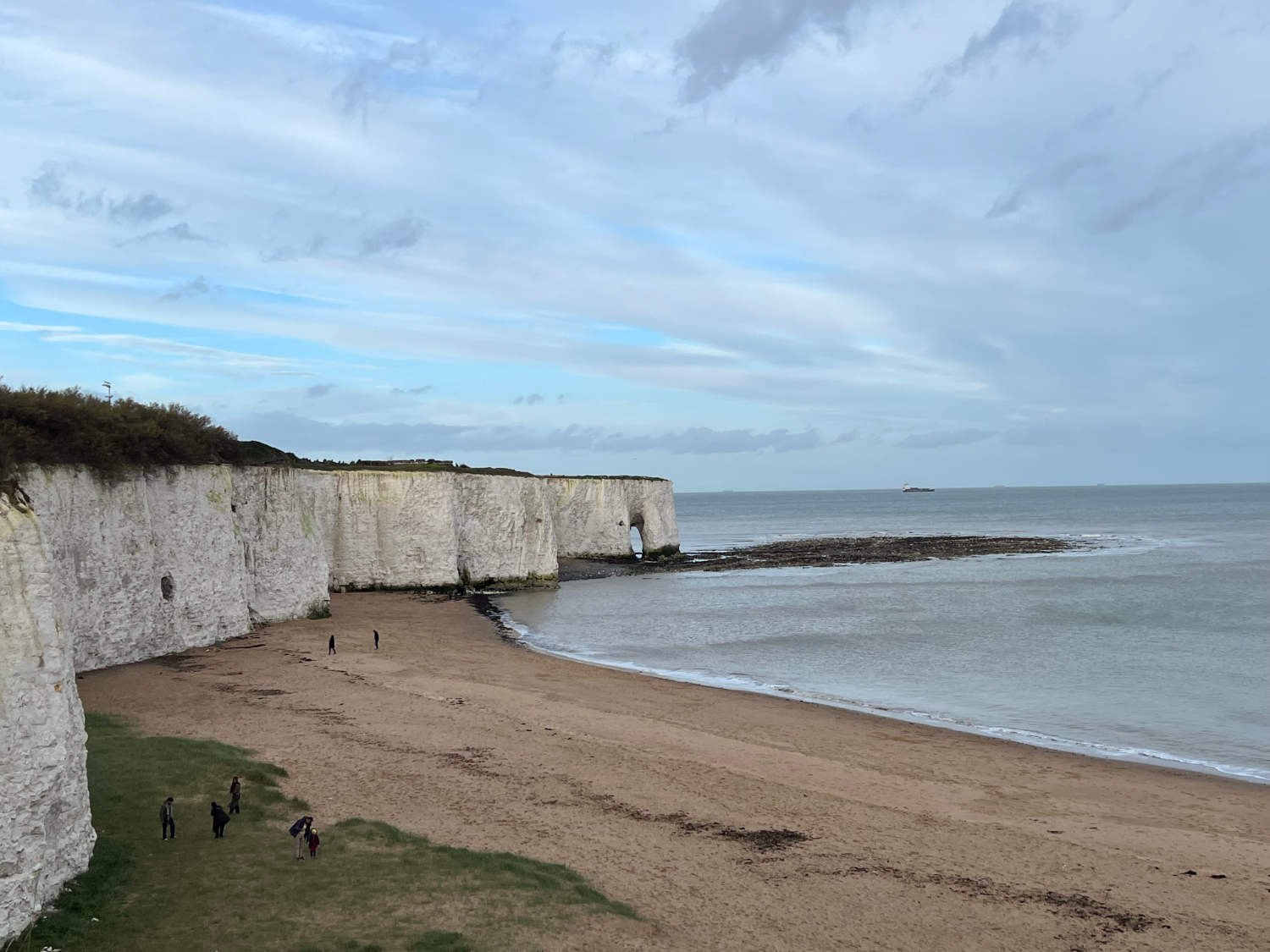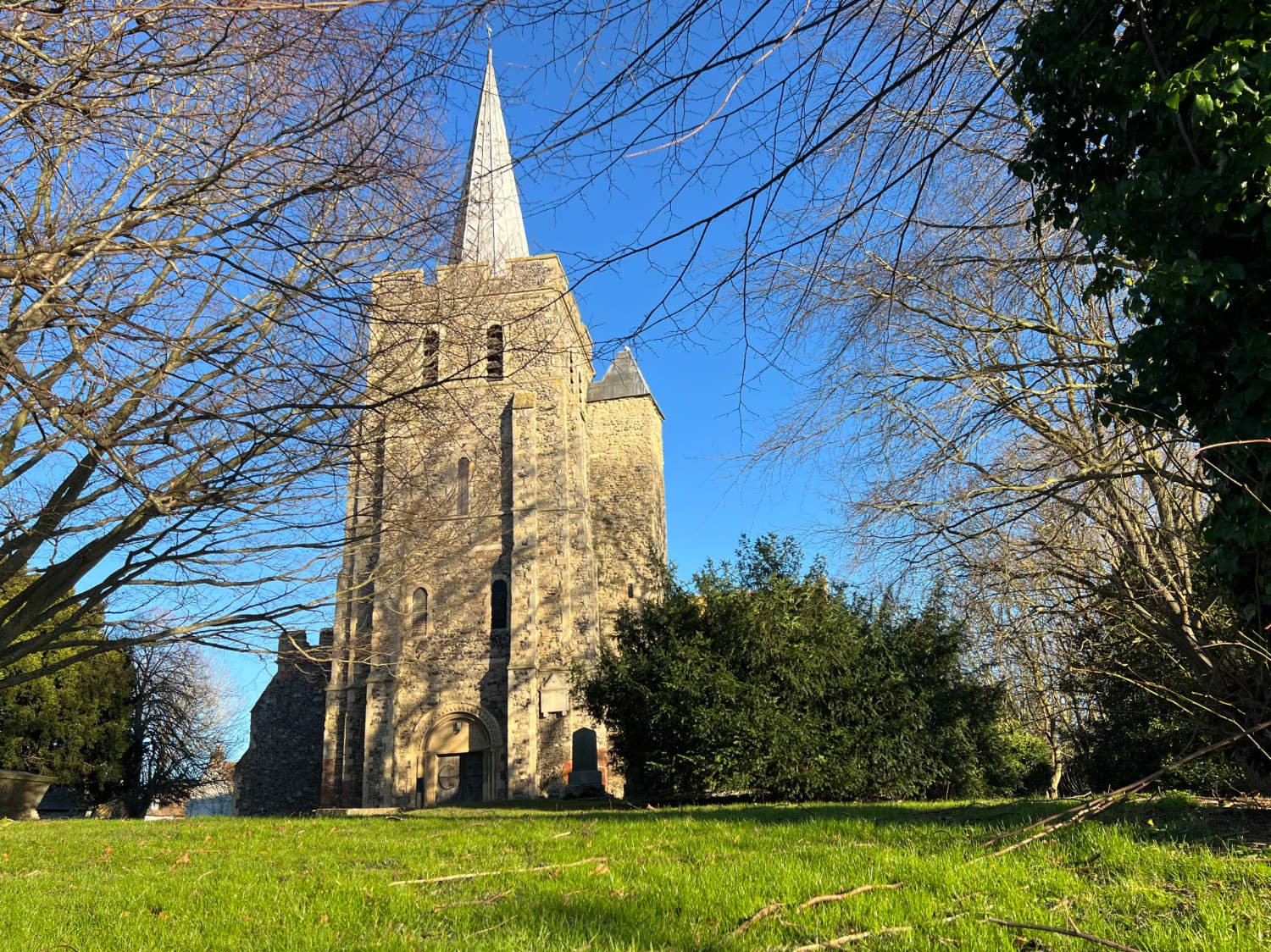65km The Viking Way
Beach huts near Herne Bay
Oysters, chalk and sand
Ride overview
Despite the easy terrain and the relatively short distance, the route it is not a quick spin - the sea un-hurries you. It is a supreme winter coastal ride on flat, traffic-free asphalted paths beside the sea. The views are constant and extensive; gaudy beach huts, chalk cliffs, the Thames Estuary, ships, wind turbines and Channel Forts. On the landward side; monasteries, Roman forts, lighthouses, Viking boats and salt marsh. There are many reasons to stop - a dip in the sea pools, or at the many outstanding cafes. There’s no need to stuff into your jersey for there are countless restaraunts ranging from the Michelin starred to Fish and Chips. Above all, it is the light, a magical, argent light which has delighted artists from JMW Turner to Tracy Emin, which will hold you. The sunsets are - according to the local tourist centres - some of the best in the world. Since the path is closed to cyclists in summer months, the route is an ideal winter ride.
(Route revised January 2024)





















Ride Practicalities
Around Herne Bay and Margate there are bans on cycling for long stretches of the seaside path between May 1 to September 30, 10.00 -18.00. Be aware that the path is shared in all seasons with pedestrians and their dogs, although in on crisp winter days, I’ve never experienced more than a very few others.
START/FINISH: Herne Bay DISTANCE: 65km. TOTAL ASCENT: 441m TERRAIN AND SURFACES: An entirely traffic-free asphalt cycle path to Ramsgate. Thereafter quiet country lanes complete the loop around the Isle of Thanet on quiet(ish) country lanes. FOOD: Margate; Peter’s Fish Factory, Buoy and Oyster, Angela’s MAINLINE TRAIN SERVICES: HS1 trains stop at Herne Bay, Margate and Ramsgate LINKS TO OTHER RIDES: NCN 1, The South Coast Route, NCN 15, The Thames Estuary Cycle Trail
Ride Notes
Before you is a huge expanse of flat sea. You are in the further reaches of the Thames Estuary, arguably the most famous estuary in the world. There are no rocky cliffs, no huge waves, rather if the tide is out, there is a sandy beach. Should the tide be in, you are faced with a tea-stained water, which even in wind seems to be reasonably calm. But it is the light, that silver, silky light which will be at the heart of things. Thames light is special -JMW Turner loved it so much that he moved here and painted note book after notebook of sky scapes. Countless other artists have followed. As you look out to sea you notice what looks to be an island of girders. It is all that is left of what was until 1978, the second longest pier in the UK, (after Southend. Beyond it, is the London Array, a collection of 175 wind turbines and beyond that, just visible, the Maunsell Forts. Herne Bay was a popular Victorian seaside resort and it has one of the best esplanades of the whole route. The General Bandstand, the Clock Tower, the municipal gardens, and the Winter Gardens are superb examples of Victorian seaside architecture.
Setting out along the Viking way (signed throughout), the cycling is a joy - the path is wide and flat throughout. On a crisp winter’s day, it is largely unpeopled.
Recluver
Out of Herne Bay there is a short, climb up to the top of the chalk cliffs before a ride over short cropped grass to the ‘twin sisters’ as the two towers of Recluver, are locally known. In what remained of a Roman fort, a Saxon monk built a monastery in 669, which as with the fort before, was laster abandoned and fell to ruins. Centuries later, Trinity House, (who are responsible for Lighthouses in the UK) bought the ruins and restored the towers as navigational aids.
A few metres onwards, you ride beside a massively thick flint wall. This is all that remains of Regulbium, a Roman fort which protected the northern approaches to the Wantsum Channel. At the foot of the wall is a mass of rich green Alexanders, a plant brought over by the Romans. The stems are delicious and it is sometimes referred to as ‘poor man’s asparagus’. They are at their tastiest from mid-winter to early spring. Pick some stems, take them home, braise them a little butter and you’ll never want imported asparagus again.
The Chalk reef, Minnis Bay
Following the Viking trail, you pass the King Ethelbert pub and descend towards the old Wantsum channel and the Chislet marshes. Looking across the wide expanse of marsh, dykes and fields it is hard to believe that the Wantsum not only separated the Isle of Thanet from the Mainland but until Medieval times when it silted up, was a major shipping channel. The route continues along a shell and seaweed strewn path following the sea wall. The horizons are huge, the reed beds rustle and in times when there is no Avian flu, the sky is filled with the song of pipits and skylarks, and occasionally curlews. At Birchington diminutive white cliffs arise beside the path, and after five kilometres of coves, chalk reefs, cliffs and sandy beaches you arrive at Margate.
Margate
For over 250 years Margate has been one of the principle seaside resorts of England. It has one of the oldest rollercoasters in the country, the oldest scenic railway and now the Turner Contemporary Art Gallery, along with many fine restaurants and eclectic shops. The place buzzes all year. It manages to mix seediness with elegance in a way which few other towns can boast.
The next few kilometres are wonderful seaside riding over white cliffs. At Botany Bay there’s a geological display stacks and arches. If you are a lover of the Shipping Forecast youll know that once you pass North Foreland Light, you leave the Maritime Sea Area of Thames and enter that of Dover.
Broadstairs
Broadstairs, the fourth town of the route is full of old-school charm, Dickens memorabilia, beach huts, Victorian ironwork and a very photogenic Viking Bay Beach. Even in the depths of winter, there is still the need for a seaside ice-cream and the famous, long established Morelli’s is the place to buy one.
It’s easy and mainly traffic-free riding to Ramsgate. The views out to sea continue to be wonderful, but the huge and very grand Arts and Crafts mansions which you pass are the chief distraction. Entering the town you ride past late Georgian crescents and terraces, before riding downhill to the to the harbour. If you need a break and some food, Union in the town centre will do you well with soups and light lunches.
Pegwell Bay, thought to be St. Augustine’s landing place
Riding out of Ramsgate you ride back up onto the cliff tops and ride on traffic-free paths with the sparkling sea beside you. There’s a Viking ship to see and at Pegwell Bay, you pass the traditional landing place of Augustine and his Christian missionaries. Seeing the marshy, reed filled bay, surrounded by thorns, you can understand why St. Augustine pleaded with the Pope not to be sent to this land. It is not the easiest of landing spots. Still, he waded through the reeds and Britain was turned towards the Roman church. A kilometre in-land there is a Victorian monument commemorating Augustine’s landing.
Minster Abbey
The riding now takes on a different turn; from now until the return to Recluver, you ride on country lanes where there’s some traffic, some of which goes rather too fast for the conditions. You’ll need to re-adjust your riding and alertness.
At Minster, you ride past one of the oldest Benedictine abbeys in the land - run by nuns. It is possible to stay there for a night or two. In the village the church is a very grand affair. Continue on road through St.Nicholas-at-Wade, passing fields of grain and beat. At Recluver you re-join the path on which your rode out and from here it’s a short ride back to the start at Herne Bay and with a last wistful look at the sea, you’ll turn towards the station for the train home.






